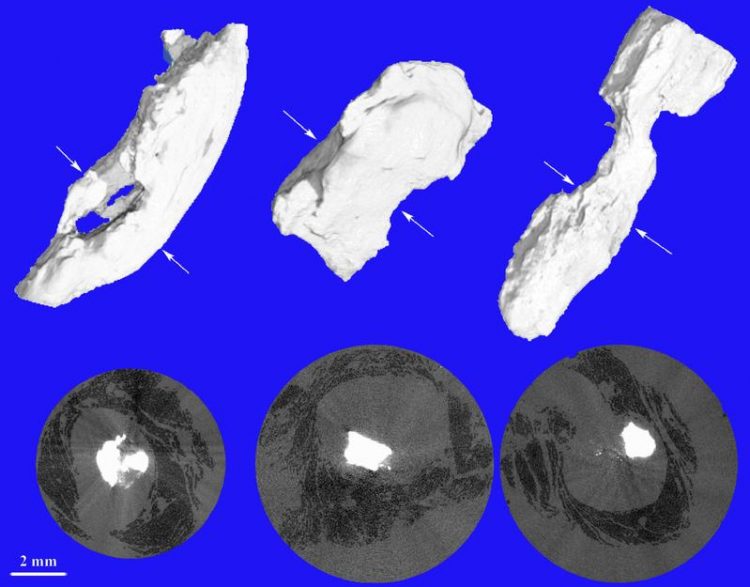Mapping Atherosclerotic Arteries: Combined Approach Developed

Conventional micro-tomography using intense X-rays allows for the visualization of plaque (white) and muscle tissue (black). Biomaterials Science Center, University of Basel
Cardiovascular diseases, including atherosclerosis, are associated with plaque formation and the most prevalent cause of death worldwide. Unlike vessels and other soft tissues, the plaque formed provides strong contrast in X-rays, as known from bone. So far, it has therefore been difficult or even impossible to identify soft tissues in the direct neighborhood of calcifications using X-rays.
A team of researchers from laboratories in three European countries, led by Bert Müller (Biomaterials Science Center at University of Basel), has developed a protocol that is based on the combination of hard X-ray tomography and established histology methods, to visualize the vessels constricted by atherosclerosis.
The data about the morphology of the constricted vessels is used to simulate blood flow and determine related shear stresses. The shear stress is significantly enhanced at the constrictions and forms the basis for the development of specialized nano-containers for the targeted and local delivery of vasodilation drugs.
Differentiation between soft and hard tissues
The new method combines known approaches and is not only suitable for the three-dimensional characterization of atherosclerotic blood vessels but also for any other combination of strongly and weakly X-ray absorbing species including cartilage and bone. It takes advantage of conventional X-ray absorption and, in addition, of X-ray phase contrast measurements, which are for example accessible via grating interferometry. As the phase contrast is much less dependent on the atomic number of the constituents than the absorption contrast, the soft tissues in the vicinity of hard tissues become much more easily visualized.
In summary, the authors demonstrate that strongly calcified arteries are thoroughly characterized by the combination of the non-destructive tomography measurements in X-ray absorption and phase contrast modes, and established histology techniques. The project “NO-stress” is funded within the National Research Programme NRP 62 “Smart Materials” by the Swiss National Science Foundation.
Original citation
Margaret N Holme, Georg Schulz, Hans Deyhle, Timm Weitkamp, Felix Beckmann, Johannes A Lobrinus, Farhad Rikhtegar, Vartan Kurtcuoglu, Irene Zanette, Till Saxer, Bert Müller
Complementary X-ray tomography techniques for histology-validated three-dimensional imaging of soft and hard human tissues
Nature Protocols 9, 1401-1415 | doi:10.1038/nprot.2014.091
Further information
Prof. Bert Müller, Biomaterials Science Center at the University of Basel, Tel. +41 (0)61 265 96 60, E-Mail: bert.mueller@unibas.ch
http://www.nature.com/nprot/journal/v9/n6/full/nprot.2014.091.html – Full Version
Media Contact
More Information:
http://www.unibas.chAll latest news from the category: Materials Sciences
Materials management deals with the research, development, manufacturing and processing of raw and industrial materials. Key aspects here are biological and medical issues, which play an increasingly important role in this field.
innovations-report offers in-depth articles related to the development and application of materials and the structure and properties of new materials.
Newest articles

Optimising the processing of plastic waste
Just one look in the yellow bin reveals a colourful jumble of different types of plastic. However, the purer and more uniform plastic waste is, the easier it is to…

Anomalous magnetic moment of the muon
– new calculation confirms standard model of particle physics. Contribution of hadronic vacuum polarization determined with unprecedented accuracy. The magnetic moment of the muon is an important precision parameter for…

Antibodies can improve the rehabilitation of people with acute spinal cord injury
Antibody that Neutralizes Inhibitory Factors Involved in Nerve Regeneration Leads to Enhanced Motor Function after Acute Spinal Cord Injury. Researchers at 13 clinics in Germany, Switzerland, the Czech Republic and…



